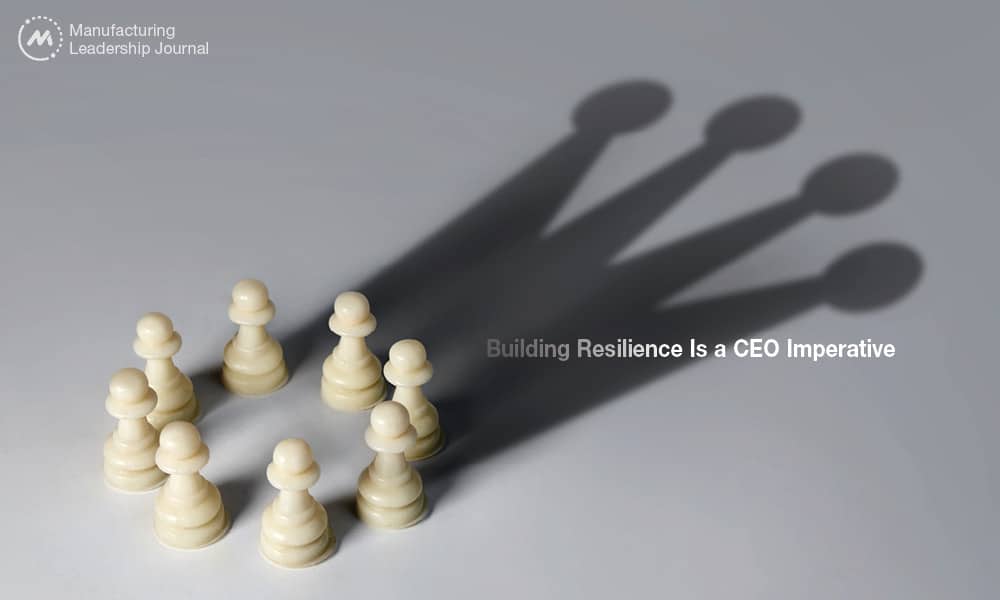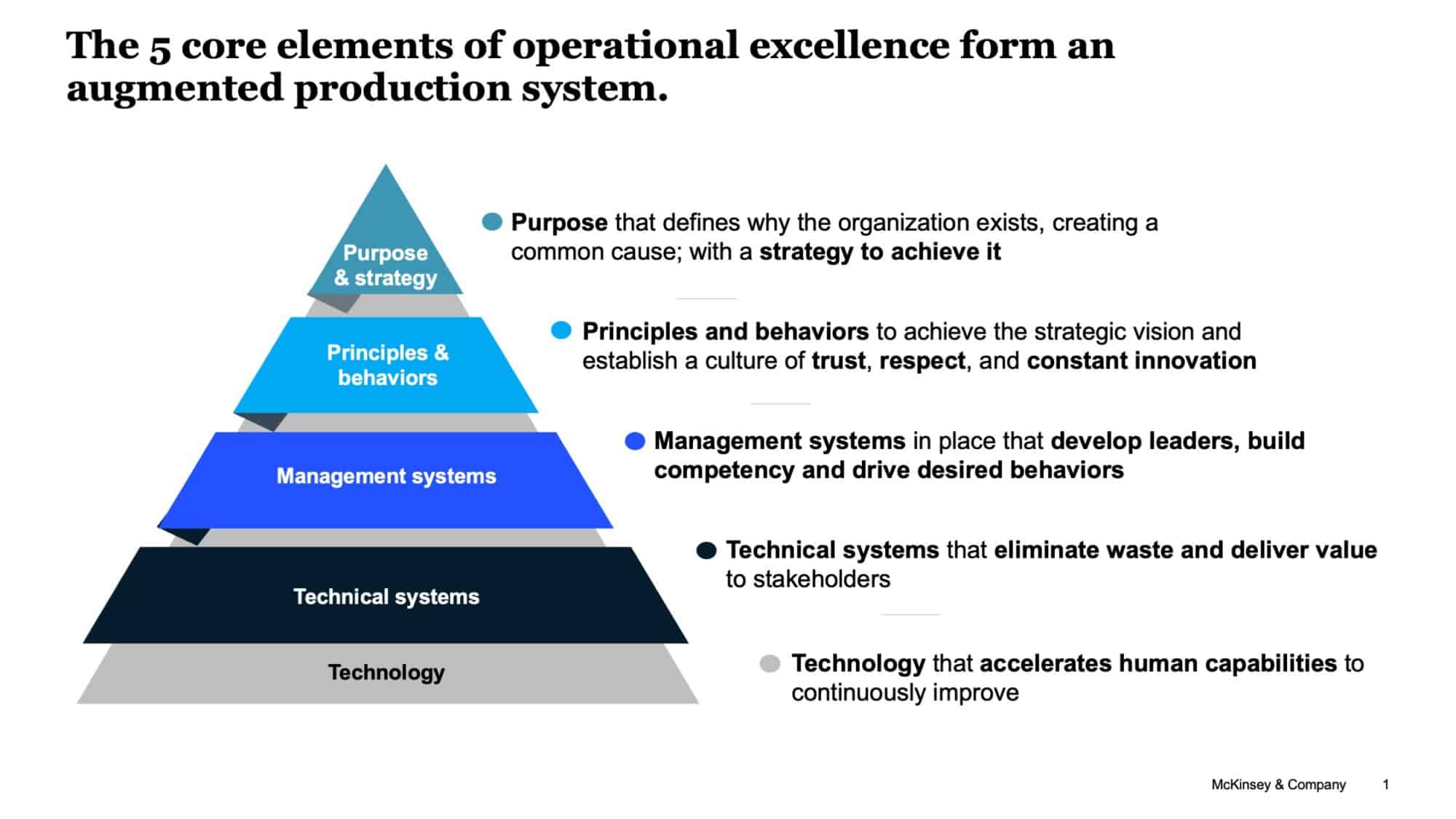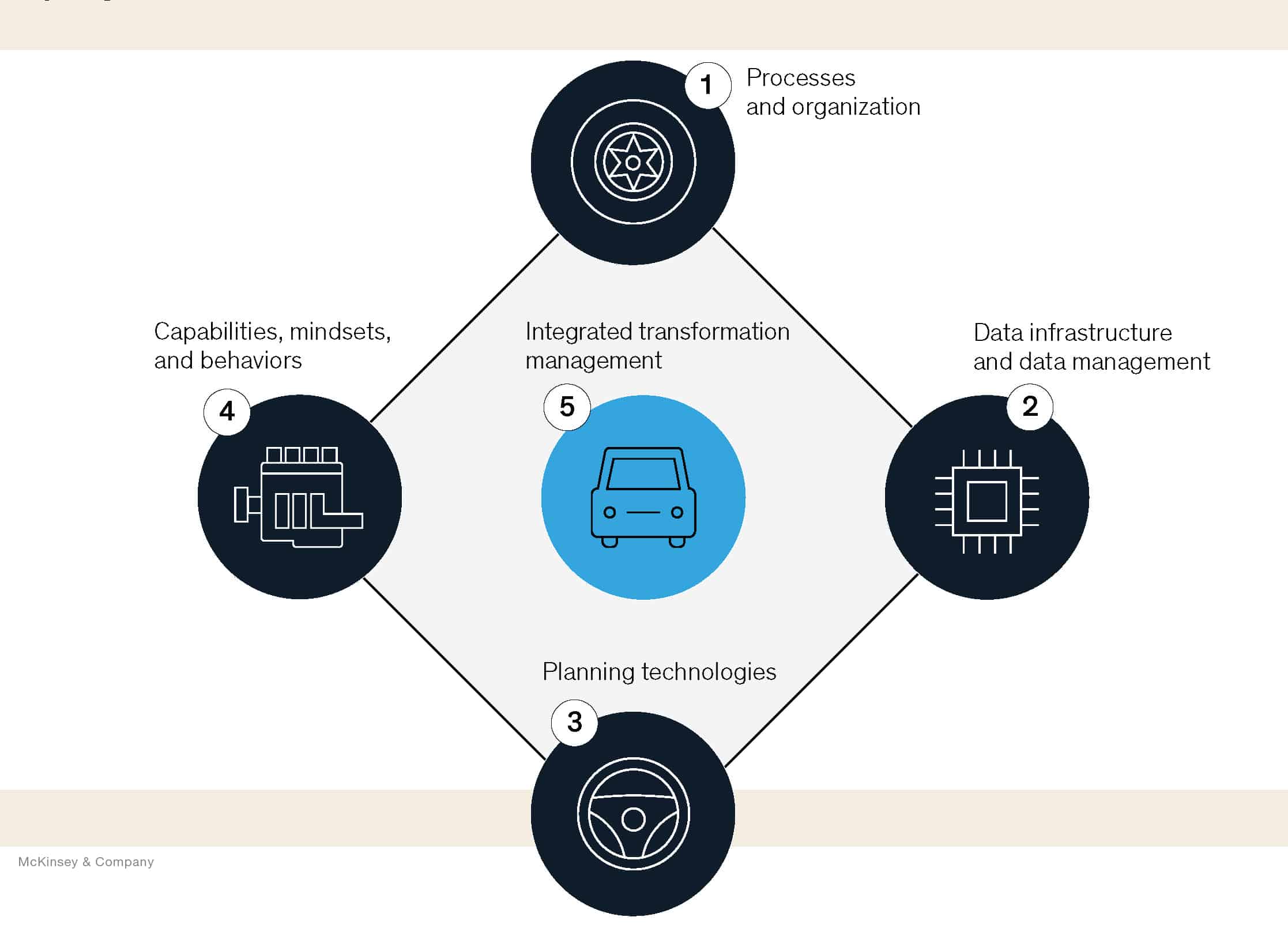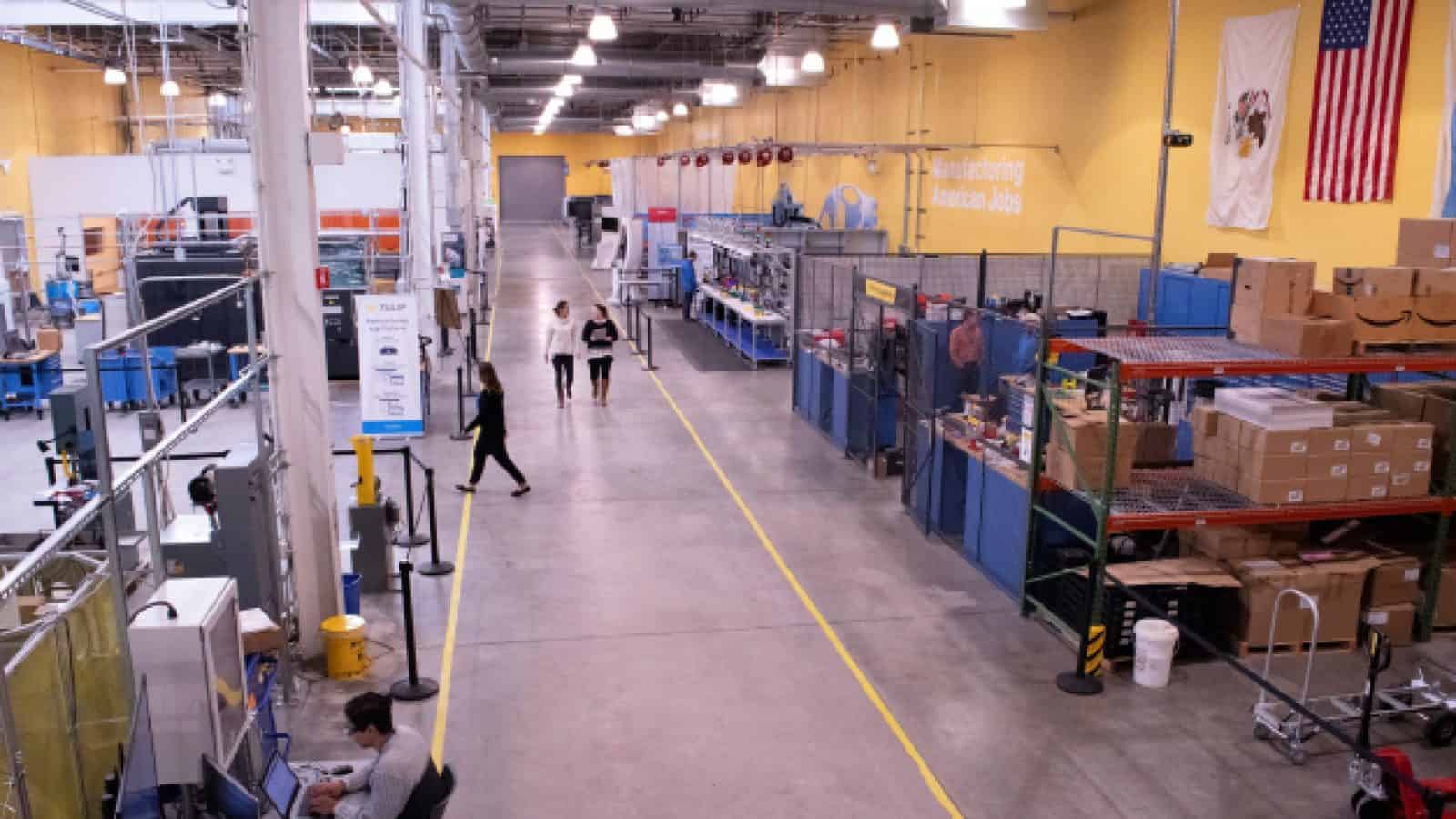Building Resilience Is a CEO Imperative

Manufacturing companies can future proof their supply chains using digitization, Lean and Agile methodologies, and other industry 4.0 technologies.

TAKEAWAYS:
● CEOs must build resilience to navigate shocks and disruptions and exploit emerging opportunities.
● Using Manufacturing 4.0 technologies, companies can make their supply chains more resilient and agile and unlock up to $1.5 trillion in value.
● Digitization can improve transparency and give companies unprecedented access to valuable information.
Trends around volatility and the need for productivity and resilience create tough operational questions for the CEOs of manufacturing companies. These are some of the most pressing questions: Can we meet customer demand, both today and tomorrow? Should we boost capacity to prepare for a prolonged period of rapid growth or reduce it to prepare for the threat of stagflation? Where will we get the skilled, digitally savvy workforce we will need in the coming years? How do we decarbonize, minimize regulatory risk, and still stay in business?
Too often, the answers reveal that a company’s operations are not fit for purpose in today’s complex, uncertain, and fast-changing environment. Modern global supply chains and Lean production systems were designed to deliver high-quality products and services at the lowest possible cost. They work best when supply and demand behavior are well understood and when every participant in the value chain is performing as expected. Today, that design is proving to be costly. Modeling by the McKinsey Global Institute suggests that, over a decade, the average company in the S&P 500 can expect that supply chain disruptions will cause losses equivalent to approximately 42 percent of one year’s earnings.
Slowdowns in productivity have compounded these volatility effects. According to the Bureau of Labor Statistics, manufacturing labor productivity fell 2.5 percent in Q1 2023, the sixth time in the past seven quarters. With disruptions expected to become more frequent as turbulence from political and environmental events continues to impact economies, this does not bode well for manufacturers looking to be more agile, productive, and sustainable—with less. There is a clear imperative for CEOs to look to their operations leaders to run the business today while planning for tomorrow; indeed, resilience is about getting many things right, at the same time.
Three Business-Operations Imperatives for the CEO
Companies now need both the resilience to ride out shocks and disruptions and the agility to exploit emerging opportunities. They will also need to master fast, effective, coordinated, and large-scale change. These attributes can’t be bolted on to slow-moving, inflexible operating models. Instead, companies need to build them into their organizational structures and processes and train up their staff.
The CEO is the catalyst for such transformation, supporting the COO and engaging the entire senior-leadership team. CEOs can set their organizations on the right path by focusing on three critical starting points:
- Setting up resilient, risk-tolerant supply chain structures that abandon outdated ideas about centralization and scale;
- Doubling down on digitization with bold investments designed to achieve a truly end-to-end vision of what the future promises; and
- Achieving real agility throughout the organization via better real-time visibility and systematic response to external developments.
Rethink Supply Chains
Companies have a once-in-a-generation opportunity to future proof their supply chains. CEOs who recognize the need for supply chain leadership in the C-suite will prosper. The ground-level view supply chain leaders have gives them the clearest and furthest-reaching vision. The processes that they work every day to perfect are the key to an organization’s stability and sustainability. And the resilience they aim to build into the system is the biggest kind of thinking there is, because it is resilience that will safeguard business against an ever more disruptive future.
Supply chains are a priority because disruption is unpredictable yet inevitable—a known, manageable risk. Consider Toyota. After the Tohoku earthquake in Japan in 2011, Toyota’s production in the region was down for six months. To avoid this sort of disruption in the future, the carmaker regionalized its supply chains and addressed supplier vulnerabilities. When another earthquake hit in 2016, Toyota lost production for just two weeks—that is resilience in action.
Rethinking supply chains, the way Toyota did, is difficult. Finding and qualifying alternative suppliers is also difficult. Logistics networks and flows are tricky to set up, integrate, and optimize. Building new plants, or closing old ones, is a complex, costly exercise. As a result, many organizations’ supply chain structures tend to be set up to meet yesterday’s requirements rather than tomorrow’s.

“Manufacturing 4.0 has the potential to unlock up to $1.5+ trillion in value, while bolstering supply chain agility and resilience.”
To close that gap, companies should empower their supply chain leaders to assess their networks and structures. Some of the paradigms that have long driven footprint-design decisions are now ripe for reconsideration. McKinsey research in the automotive sector, for example, found that midsize supplier plants with 1,000 to 1,500 direct employees were almost twice as likely as their smaller or larger counterparts to achieve top-quartile productivity. Manufacturers that split production over several medium-size plants rather than one mega factory may also benefit from closer proximity to customers and reduced location risks, such as weather-induced shutdowns and energy price spikes.
Prioritize Digitization
Manufacturing 4.0, the next phase of operational excellence in manufacturing, is here. These technologies have the potential to unlock up to $1.5+ trillion in value, while bolstering supply chain agility and resilience. While this goal should be well within reach, in fact, more than 70 percent of digital transformations fail to deliver, and companies struggle with issues of data fragmentation, variable IT and OT systems, unsupported legacy systems, and the increasing pressures of the talent market.
A handful of companies have found a new way to operate that is revolutionizing how they create value in operations. The combination of Lean and technology is allowing these companies to create new augmented production systems that sustainably capture the full value of digital at scale, with a holistic approach built on strong organizational foundations. The benefits include year-on-year improvements in productivity, environmental protection, safety, employee engagement, and customer satisfaction.
Figure 1: Five core elements of operational excellence

The most successful initiatives share a handful of characteristics:
- Ownership through robust understanding and conviction: Across all levels of the organization, leaders and frontline operators ought to understand and fully support the use of technology in their day-to-day decision-making processes. The leaders of one large mining company, for example, built understanding and conviction through a bottom-up process. They organized technical workshops to define a shared vision for the future functioning of their operations, so that the entire organization could see how the effort would improve its work.
- Updated organization and management systems for optimal decision-making: High-performing organizations structure teams in working cells linked to value streams (such as end-to-end operations, reliability, or planning), rather than the value chain’s individual process components (such as mine operations, plant operations, and technical services). At another mining company, this structure empowered one product owner to make decisions across the entire value chain, therefore aligning objectives and performance metrics with bottom-line business results.
- Evolved roles and capabilities to empower and engage the front line: Companies that have succeeded in using technology to achieve operational excellence, adapt roles and capabilities to suit the new ways of working required to sustain, and continuously improve technology solutions. Product owners are empowered and accountable. Data scientists and engineers use data collected throughout the process to build optimization models that assist in decision-making. “Translators”—that is, staff who work in the Transformation Office and have deep domain knowledge and technical fluency—serve as a communication bridge between processing experts and the digital team. Finally, frontline leaders are supported by everyday insights from AI tools, with more scope to improve operations, pilot new ideas, and collaborate with their colleagues upstream and downstream.
Create Agility, Visibility, and Systematic Response
Too many companies still run their operations blindfolded. Limited information sharing and collaboration among functions, sites, and business units make optimal decision-making slow and unwieldy—or impossible. Internal coordination is only a fraction of the challenge. Companies’ knowledge of the situation at their direct suppliers is usually patchy at best. Their picture of the deeper tier-n supply chain is practically nonexistent—many lack the systems and structures necessary to mount an effective and timely response.
Instead of lurching from operational crisis to operational crisis, CEOs naturally want to be able to navigate complexity and uncertainty. Digitization can partially solve the transparency problem. New and emerging digital solutions are giving companies unprecedented access to external information that could affect their business operations, from logistics disruptions to environmental, social, and governance risks and prospective changes to legislation. Leading organizations are already building operational control towers that act as central hubs for a wide range of operationally relevant data.

“Limited information sharing and collaboration among functions, sites, and business units make optimal decision-making slow and unwieldy—or impossible.”
The value of that data is limited by the organization’s ability to analyze and act upon it, however. In recent years in response to the global challenges they face, many companies have shifted from manual short-term solutions to longer-term solutions for transparency and planning that incorporate advanced technologies. Such technologies are not limited to monolithic architectures and are often the result of advanced planning systems (APSs) that combine bespoke advanced-analytics (AA) models for increased functionality.
Building advanced planning capabilities requires transformation. In a recent survey, McKinsey found that nearly 90 percent of global supply chain leaders have started or expect to soon overhaul their current planning IT. The same survey also found that 60 percent of these transformations take more time or money than expected or don’t achieve anticipated business outcomes.
The winning recipe for a successful transformation requires integrating five ingredients to deliver at-scale impact.
- Processes and organization: A cross-functional approach beyond IT highlights opportunities for optimization, including offering value-added services to customers or driving profitability through the coordination of sales and operations.
- Data infrastructure and data management: Digital planning requires four system layers to integrate seamlessly: a system of innovation, APS as a core planning software, a data consolidation layer, and a system of record for ERP data.
- Planning technologies: Companies should select suppliers through an assessment of capability to build a two-level architecture that combines APS technology with AA solutions, such as advanced prediction and optimization algorithms.
- Capabilities, mindset, and behaviors: To develop talent with more-complex skill profiles, companies can create two new types of capabilities: one with a combination of functional, technical, and leadership competencies to drive performance; and another with technical competencies to build, maintain and develop core AA-model archetypes.
- Integrated transformation management: Leaders can focus on value-led transformations by implementing guardianship around three distinct, equally important, and mutually reinforcing pillars of responsibility: design, delivery, and value.
Linking these five ingredients will require fundamental shifts in the ways of working for organizations undergoing APS transformations. Making these shifts can help organizations achieve their business goals on time and under budget.
Figure 2: Five ingredients to integrate APS transformations
Integrated advanced planning systems transformations require five key ingredients.

The COVID-19 crisis, the war in Ukraine, and consumer and regulatory requirements to improve sustainability, and continuing volatility in global markets have lifted operations-related issues to the top of the senior-leadership agenda. There’s good reason for them to stay there. The transition to the constantly evolving global economy is already testing the resilience of business-operations functions in multiple industries. The transition to a low-carbon economy is set to test them even further. All this turbulence is continually opening new value pools for companies with the agility to seize them. The challenge for today’s CEOs and other senior leaders is to get their organizations onto the front foot, building the supply chains, digital skills and capabilities, and organizational capabilities needed to thrive in an economy that promises to be anything but normal. M
About the author:

Dan Swan is the Co-leader of McKinsey’s Operations Practice
